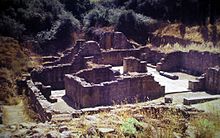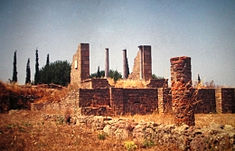- Miróbriga
-
Miróbriga (Ruínas de Miróbriga) Archaeological Ruins of Miróbriga Roman ruins (Ruinas romanas) The ruins of the Roman villa of MiróbrigaOfficial name: Estação Arquelógica de Miróbriga Country  Portugal
PortugalRegion Alentejo Sub-region Alentejo Litoral District Setúbal Municipality Santiago do Cacém Location Santiago do Cacém - elevation 226 m (741 ft) - coordinates 38°0′34.88″N 8°41′1.74″W / 38.0096889°N 8.6838167°W Length .38 m (1 ft), Southwest-Northeast Width .43 m (1 ft), Northwest-Southeast Architects unknown Style Roman Materials Stone, Rock, Tile Owner Portuguese Republic For public Public Visitation Closed (Mondays and on 1 January, Easter Sunday, 1 May and 25 December) Management Instituto Gestão do Patrimonio Arquitectónico e Arqueológico Tuesday-Saturday 9:00 a.m.-12:30 p.m.; 2:30 p.m.-5:30 p.m. Sunday 9:00 a.m.-12:30 p.m.; 2:30 p.m.-5:30 p.m. Status Property of Public Interest Listing Decree No.30/762, DG No.225, 26 September 1940 Wikimedia Commons: Miróbriga Website: http://mirobriga.drealentejo.pt/ Miróbriga (Mirobriga Celticorum) is an ancient Roman town located near the village and civil parish of Santiago do Cacém, in the municipality of the same name in the south-west of Portugal. Archeology revealed a that the town occupied the site of an ancient Iron Age settlement that existed since the 9th century B.C.
With the Roman colonization a commercial area developed around the Forum. The baths, among the best preserved in Portugal, consist of two adjoining buildings, possibly for male and female use respectively. The residential areas are still little known. Relatively close to the baths, there is a bridge with a single, semicircular arch. The hippodrome, the only one whose entire ground plan is completely known in Portugal, is located further from the centre.
Contents
History
Excavations and investigations (W. Biers, 1988), suggest that the earliest settlement began to take shape in the 9th century B.C. (Iron Age), and that the defensive walls began appearing between the 4th-3rd century B.C. This settlement occupied an area of 11,800 m², with the population inhabiting the area along the embankment and north-east corner of Castelo Velho, of which only a wall and temple remains (alongside the Roman forum).[1]
By about the second half of the 1st century Roman occupation began, expanding the site and occupying an area of 28,000 m². At this time the thermal baths and paved road along the southeast were constructed, reflecting the Flavian economic prosperity.[1] Around the first half of the 2nd century, the construction of the Oriental baths and hippodrome was began, followed by a second phase of construction in the second half of the 2nd century and 3rd century.
Around the second half of the 2nd century, there were signs of abandon, that may reflect the period of political crisis caused by barbarian invasions during this period. By the end of the 4th century, there is a marked reduction in the population, although a level of continuity persisted on the site: primarily around the small Chapel of São Brás.[1]
The ruins were rediscovered and referenced by André de Resende in the 16th century, but they were never fully studied until the 18th century.[1][2]
On 1 June 1992 the Instituto Português do Património Arquitectónico (IPPAR) (forerunner of Institute for the Management of Architectural and Archaeological Heritage took over the management of the site, by Decree-Law No.106F/92.[1] This was followed in 1996-1997 by the acquisition of the lands that surrounded the site, as part of the ZEP-Zona de Protecção Especial (Special Protection Zone) designation. On 1 February 1999, a dispatch (No.180/99) from the Ministries of Equipment, Planning and Territory Administration, Ministry of the Environment and the Ministry of Culture, recognized the importance of safeguarding the Roman ruins, and authorized the construction of an Interpretative Centre.[1] The project began in 2000, in a project designed by architect Paula Santos, that included a 700 m² space.
Architecture
Castelo Velho hill (245 metres) dominates the site that is one kilometre north-west from the urban centre of modern Santiago do Cacém, which overlooks the northern plain of Chãos Salgados.[1] Miróbriga is situated in a privileged location, on the ancient roadways of the region with access to the coast. Within close proximity is a Windmill of Cumeadas.
Baths
 A partial view of the Thermae of Miróbriga
A partial view of the Thermae of Miróbriga
The settlement is structured around Roman roads with many paved accesses. Around the west-east axis are the ruins of the residential homes. To the east, are the former baths constructed over a canal and composed of two buildings in a "L" shape ("Western Baths" and "Eastern Baths").[1][2] Each building has: an entry into the massage hall, a gymnasium, changing room, the bathing space, which included the frigidarium (cold baths, tepidarium (warm baths) and caldarium (hot baths) and a communal latrine.[1][2] The halls are warmed by a hypocaustsystem that heated the floors of baths, which was located in the south part of the buildings. It was a subterranean system formed by pillars and arches, with tile, that allowed the circulation of warm air to produce heated environments, supported by kilns.
Forum
To the east of the baths is a small, single-arch bridge, that provided access along the west-east access that leads to the "forum", an Imperial temple (to worship the Roman Emperors) and a temple dedicated to Venus.[1][2] Between these two are the remains of an older temple dedicated to the local divinity. North of the forum are the ruins of the market and the visitors houses, separated by another road.[1][2]
Hippodrome
The hippodrome was a rectangular space with curved seating on the northern end, while segmented seat on the south, used for chariot or horse races.[2] It was a 370 metre by 75 metre space, bisected by a spine with posts on either end, and a triumphal arch on the south entrance.[1]
Interpretative Centre
The Interpretative Centre (the most recent addition) is located on an elevated area at the entrance to the site, with several paths leading away from this site into the ruins.[2]
See also
- Lusitania
- Sines (the bay of Sines was used as port by the civitas of Mirobriga)
References
- Notes
- ^ a b c d e f g h i j k l Mendonça, Isabel (1992). "Área do Castelo Velho, com as ruínas da cidade romana adjacente/Estação Arquelógica de Miróbriga/Ruínas de Miróbriga". In SIPA (in Portuguese). Lisbon, Portugal: SIPA – Sistema de Informação para o Património Arquitectónico. http://www.monumentos.pt/Site/APP_PagesUser/SIPA.aspx?id=4076.
- ^ a b c d e f g IGESPAR, ed. (2011) (in Portuguese), Área do Castelo Velho com as ruínas da cidade romana de Miróbriga, Lisbon, Portugal: IGESPAR - Instituto Gestão do Patrimonio Arquitectónico e Arqueológico, http://www.igespar.pt/en/patrimonio/pesquisa/geral/patrimonioimovel/detail/69756/, retrieved 26 July 2011
- Sources
- Cruz e Silva, João Gualberto da (1946) (in Portuguese), Apontamentos e considerações sobre as pesquisas arqueológicas realizadas desde 1922 nos concelhos de Santiago do Cacém, Sines e Odemira, 3, Beja, Portugal: Arquivo de Beja
- MOP, ed. (1949) (in Portuguese), Obras em Monumentos Nacionais - Congresso Internacional de História da Arte, s.l., Lisbon, Portugal: Ministério das Obras Públicas/DGMEN
- Almeida, D. Fernando de, "Nota sobre os restos do circo romano de Miróbriga dos Célticos" (in Portuguese), Revista de Guimarães, 73, Lisbon, Portugal
- MOP, ed. (1956) (in Portuguese), Relatório da Actividade do Ministério no ano de 1955, Lisbon, Portugal: Ministério das Obras Públicas
- Correia, Susana (1987), "Estação arqueológica de Miróbriga (Santiago do Cacém). Balanço de uma investigação e perspectivas de intervenção futura" (in Portuguese), Anais da Real Sociedade Arqueológica Lusitana, 1, 2ª série, Santiago do Cacém, Portugal
- Biers, W., ed. (1988) (in Portuguese), Mirobriga - investigations at an Iron Age site in southern Portugal by the University of Missouri-Columbia, 1981-1986, Oxford, England: Oxford University Press
External links
Categories:- Roman sites in Portugal
- Roman towns and cities in Portugal
- Ancient Roman geography
- Ancient Roman Empire
Wikimedia Foundation. 2010.


